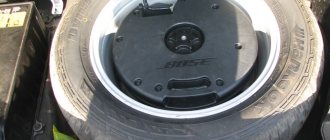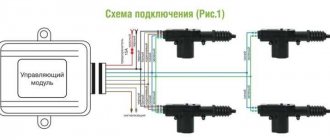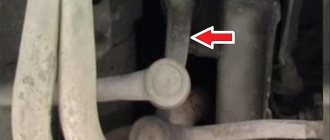A modern car is a real computer with an electronic control unit and an abundance of sensors. Accordingly, there is complex electrical wiring and a fuse box. If something doesn't work, that may well be the reason. But you don't have to be an auto electrician to find out the cause of a wiring problem. The two most common electrical problems are:
- broken wires;
- short circuit (“short circuit” or “short circuit”).
While the first is self-evident, the second is somewhat more complicated, so in this article we will look at exactly how to find a short circuit in a car.
He who seeks will find
It is best to look for a short circuit in the car's electrical wiring using a multimeter. The preliminary search is carried out by eye. But in all cases, it is extremely necessary to have a diagram of the electrical circuits of the machine at hand. First of all, they turn to the fuses, because when they are shorted, they burn out first. Two possible sources of short circuit:
- wires;
- consumers (all devices and instruments that are connected to a specific line).
The latter are the easiest to exclude; in the first case, it may be necessary to disassemble the entire vehicle. The fuse corresponding to its circuit will indicate to you the defective unit. In the safety block you will find relays with identifying marks. See your vehicle's manual for guidance.
How to detect a fault
If one of the electrical devices or actuators stops working, then there is no need to rush to replace it. It cannot be ruled out that the cause of the failure is hidden in a wiring malfunction, and installing new equipment will not solve the problem.
Any factory manual for a car recommends starting the search for the cause of malfunctions by ringing the electrical wires connecting this device or mechanism to other components.
To do this you need to arm yourself with:
- multimeter;
- or a 12 Volt signal lamp with connecting wires.
How to use a multimeter
In the video in this article you can see some aspects of working with measuring equipment when carrying out work to detect breakdowns in the on-board electrical network. And the main tool of any auto electrician has been and remains a multifunctional digital device - a multimeter. (See also the article VAZ 2105 wiring diagram: description.)
For reference: A multimeter is a universal device that simultaneously combines an ohmmeter, an ammeter and a voltmeter. A voltmeter is responsible for measuring the voltage of the on-board circuit, an ammeter measures the current, and an ohmmeter determines the resistance accordingly.
Voltage check
So, if one of the electronic components in a car stops working, then the first thing you need to do is check the voltage of the electrical circuit that connects it to other devices. (See also the article Gazelle wiring diagram: how to install.)
- Switch the multimeter to voltmeter mode;
- We connect one of the probes of the device to the negative terminal of the battery (if the device being tested is under the hood) or to the ground of the car, trying to choose a place on the body with good contact;
- We connect the second probe to the supply wire in the circuit being tested, having previously removed it from the terminal of the device or instrument.
If values appear on the display, there is voltage in the wire and the wire itself is working. We carry out the operation with other wires, and when we find a point where there is no voltage in the network, we determine that the source of the fault is located in this segment.
Note! In some car electrical circuits, voltage is only present if the ignition key is set to a certain position.
Finding a short circuit
This procedure is characterized by the complete absence of voltage in the circuit.
- the fuse responsible for the circuit being tested is removed;
- the multimeter is switched to voltmeter mode;
- one of the probes is connected to the fuse connection terminals at a time when all other devices and equipment in this circuit are de-energized;
- move the wire - if values appear on the screen, then the wire is shorted.
Let's start checking
Without further ado, let's start with something simple: turn off the ignition and begin to remove the fuses from their sockets one by one, checking each of them with a multimeter. If there is no short circuit in the car wiring, the indicator will show “0”. In this way we measure each conductor (we do not stop, even if one faulty one has already been found).
The next step is to turn off the “ground” (“–” output of the electrical element in the form of a wire or product body). By the way, to find a short circuit in the wiring, not only a measuring device, but also a regular lamp from 12 to 55 Watts (side or head light) is suitable. Turn the ignition key to the starting position. We apply the probes connected to the light bulb to the terminals of the fuse holders and see if it lights up. The glow when the ground is turned off indicates the presence of a short in this vehicle wiring line.
How to find a short circuit in a car
A short circuit in a car (or “short circuit” in electrician slang) is a very serious thing. Most spontaneous car fires occur precisely because of them. How to find a short circuit in the wiring in a car?
Finding out about a short circuit is not difficult. If everything went as expected, then when a short circuit occurs, the fuse burns and the corresponding electrical circuit stops working. It can power anything from headlights to a clock in the cabin. When looking for a fault, usually the first thing to do is check the fuse and, if it is blown, insert a new one with the same rating. If the new fuse suffers the same fate, there is a short circuit in the car.
Finding a short circuit in the wiring is done by the method of elimination and is a very tedious task. Its meaning is to disconnect various electricity consumers on the corresponding power line (you can find out what exactly is powered on it from the car’s electrical circuit) and check the integrity of the wires. Check the wires passing, for example, under the dashboard
, it won’t be easy and simple, so you need to start by excluding consumers. We move on to the wires after we are convinced that the consumers are not to blame for the short circuit.
To find a device (for example, a radio) that has a short circuit inside it, the power line must be energized. How to do this, because the fuse immediately burns out? This is the whole secret of finding short circuits in a car!
Before you begin your search, you need to connect your own powerful electricity consumer to the power line. This is necessary in order to reduce the high short circuit current and prevent the wiring from catching fire.
To find a short circuit in a car, you can use a regular headlight lamp
The easiest way to do this is with a regular 55-watt headlight bulb, switched on instead of a fuse. That is, you need to take a light bulb, connect two wires with terminals pre-crimped onto them to its terminals (Read how to crimp a terminal on a wire in a car
) and other ends of the wires are connected instead of the fuse.
You need to connect through the terminals, that is, securely. If the fuses are modern “flag” type, then the male terminals
.
female terminals
on them . The connection must be in series, that is, the current must pass through the bulb.
The lamp must be positioned so that it is visible. The moment it is connected to a short-circuited power line, it will light up at full power, like a headlight. A bright glow confirms the presence of a “short man”. And now, when you turn off various devices connected to the line, you need to wait until the light goes out. This will happen when the equipment that caused the short circuit is removed from the line and the current is greatly reduced to normal values. If, when you turn off, say, the instrument backlight control, the lamp begins to glow barely, it means that you have eliminated the cause of the “short” that occurred inside the controller.
It’s another matter if all consumers have already been excluded from the line, and the lamp continues to glow at full intensity. This means that the short circuit did not occur in some consumer, but in the wiring. For example, due to damage to the wire insulation.
This situation is much more complicated, because in order to view the entire power line, most likely, you will have to disassemble the interior, remove various panels, and even the dashboard. However, if you use a multimeter, you can measure accessible sections of the power line for high current, thereby narrowing the search range. If you are not very proficient with this tool and are not familiar with electricity, it is better to entrust this matter to electricians. And not for ordinary people, but for auto electricians, because in addition to directly searching for a short circuit, a person must also be able to disassemble and assemble different parts of the car.
Once you find the device that caused the short circuit, you can try to repair it. But it’s better to replace it with a new one - short circuits are not to be trifled with. If for some reason the fuse can withstand the flow of current and does not burn out, the wiring will catch fire and the entire car will burn out.
To prevent this, you need to know how to choose fuses for your car.
,
the causes of a short circuit in a car
, and when doing electrical installation yourself, you must know
how to use electrical tape
.
The consumer is not always right
Having already identified a specific circuit and knowing (in accordance with the existing circuit) which consumers are connected to it, you can turn them off one by one and check the line again with a light bulb/multimeter. If they are not the cause, the wires remain. Finding the right one can be difficult without professional help.
The advantage of a short circuit of a specific automobile unit is that if it is not vital (for example, a radio), it will be enough to simply turn it off and move on. But such a malfunction should not be underestimated. After all, if the fuse does not blow, the whole car may burn out. Smoke and fire are the most obvious signs of a short circuit. If this happens, stop immediately and begin searching for a short circuit in the electrical wiring only when you are sure it is safe. The main thing is to be careful.
Total
We looked at how to find a short circuit in a car's wiring using a multimeter and a light bulb, focusing on the fuse box. However, if such operations are not clear to you at the cellular level, that’s okay! The Uremont tool was created especially for the convenience of ordinary car owners. This is an online platform for finding the nearest service stations in the form of a website and application, which is always at hand. Just about or call the master directly to the point of forced stopping. Professionals from the service can easily determine the location of the short circuit and fix everything. Please remember that you should always have:
- insulating tape;
- multimeter or diagnostic light;
- car on-board electronics diagram.
We hope this article was useful and you have a rough understanding of how to find a short in your car wiring. Good luck on the roads! For convenience, download the free Uremont app on Google Play and App Store.











